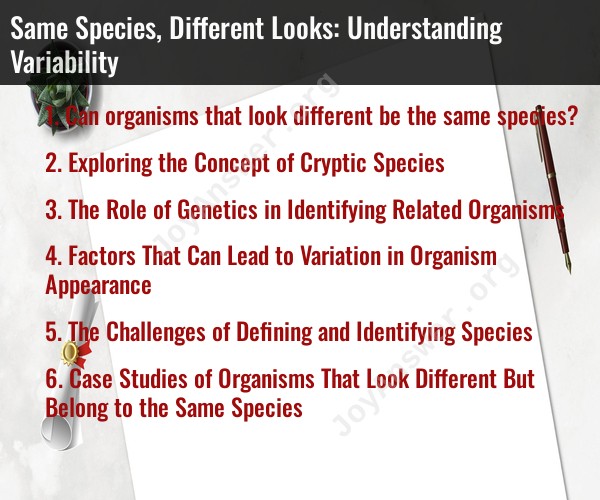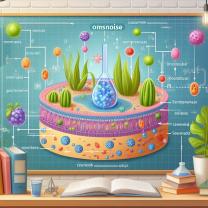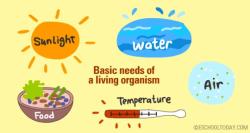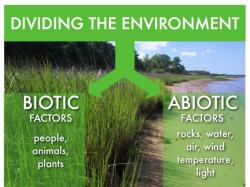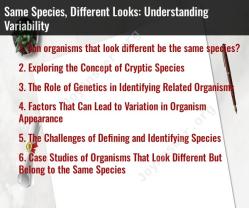Can organisms that look different be the same species?
Yes, organisms that look different can still be members of the same species. In biology, a species is defined as a group of individuals that can interbreed and produce fertile offspring under natural conditions. This is known as the Biological Species Concept. The emphasis here is on reproductive compatibility rather than physical appearance.
Variability in appearance within a species is quite common and can be attributed to a range of factors, including genetic diversity, environmental influences, and developmental variations. Here are some reasons why organisms of the same species may look different:
Genetic Diversity: Even within a single species, there can be a significant amount of genetic diversity. This genetic diversity can lead to variations in physical traits, such as color, size, shape, and other characteristics.
Geographic Variation: Organisms from the same species in different geographic regions may exhibit differences in appearance due to local environmental conditions, like temperature, humidity, and food sources.
Age and Developmental Stages: Young individuals of a species may look different from adults, and individuals at different life stages may display various physical characteristics. For example, juvenile animals often have distinct coloration or patterns.
Sexual Dimorphism: In many species, males and females have different physical characteristics. This is known as sexual dimorphism. These differences can include size, coloration, and ornamentation and are often related to reproductive roles and strategies.
Diet and Behavior: The diet and behavior of individuals within a species can impact their physical appearance. For example, diet can influence body size and the development of certain structures, while behavior can lead to differences in body shape or ornamentation.
Environmental Adaptations: Organisms may have evolved different physical traits in response to specific environmental pressures. This adaptation can result in variability in appearance, known as polymorphism.
Hybridization: In some cases, species can interbreed with other closely related species, resulting in hybrids. These hybrids may display characteristics of both parent species, making them appear different from typical individuals of either parent species.
The key criterion for classification as a species is the ability to interbreed and produce fertile offspring. Even if organisms within a species look different due to the factors mentioned above, as long as they can mate and have fertile offspring, they are considered part of the same species. This concept acknowledges that variation within a species is a natural and important aspect of biodiversity.
Exploring the Concept of Cryptic Species
Cryptic species are two or more species that are morphologically indistinguishable, meaning they look the same, but are genetically distinct. They are often discovered through genetic analysis, which can reveal subtle differences in DNA sequences. Cryptic species can be found in all groups of organisms, but they are particularly common in insects, spiders, and fish.
The Role of Genetics in Identifying Related Organisms
Genetics plays a vital role in identifying related organisms. By comparing DNA sequences, scientists can determine how closely related two organisms are. This information can be used to construct phylogenetic trees, which show the evolutionary relationships between organisms.
Factors That Can Lead to Variation in Organism Appearance
There are a number of factors that can lead to variation in organism appearance, including:
- Natural selection: Natural selection is the process by which organisms with traits that are better suited to their environment are more likely to survive and reproduce. This can lead to changes in organism appearance over time as organisms adapt to their surroundings.
- Genetic drift: Genetic drift is a random change in the allele frequencies of a population. It can occur due to chance events, such as a small population size or a bottleneck event. Genetic drift can lead to changes in organism appearance over time as different alleles become more or less common in the population.
- Gene flow: Gene flow is the movement of genes between populations. It can occur when individuals migrate from one population to another or when they mate with individuals from another population. Gene flow can lead to changes in organism appearance over time as new alleles are introduced into the population.
The Challenges of Defining and Identifying Species
Defining and identifying species can be challenging, especially for cryptic species. Traditionally, species have been defined based on morphology, but this does not work for cryptic species. Scientists now use a variety of methods to identify and define species, including genetics, ecology, and behavior.
Case Studies of Organisms That Look Different But Belong to the Same Species
There are many examples of organisms that look different but belong to the same species. Here are a few examples:
- The polymorphic praying mantis: The polymorphic praying mantis is a species of praying mantis that comes in a variety of colors and patterns. This variation in appearance is thought to be due to natural selection, as different colors and patterns may help the mantis to camouflage itself in different environments.
- The mimetic butterfly: The mimetic butterfly is a species of butterfly that mimics the appearance of other butterfly species. This mimicry helps the butterfly to avoid predators.
- The ring-necked snake: The ring-necked snake is a species of snake that has a variety of different color morphs. These color morphs are thought to be due to genetic drift.
Cryptic species are a fascinating example of the diversity of life on Earth. By understanding cryptic species, we can better understand the process of evolution and the complex relationships between organisms.
